

Book Review Worksheets
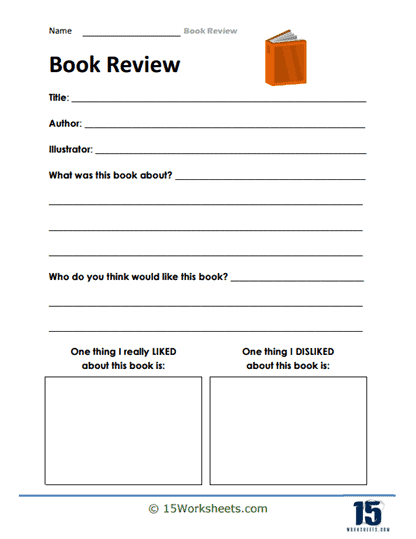
Insights And Impressions
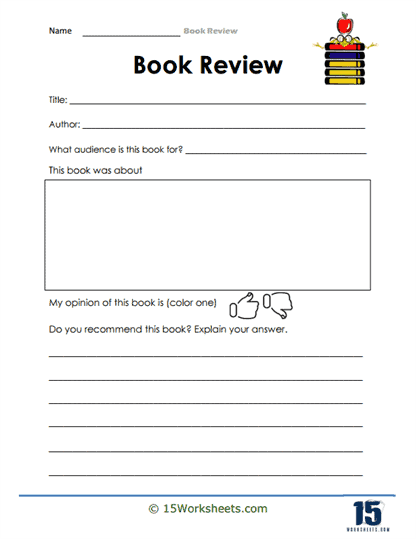
Would You Recommend It?
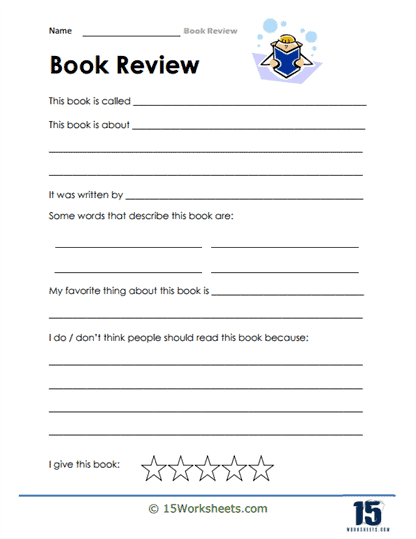
Out Of Five Stars
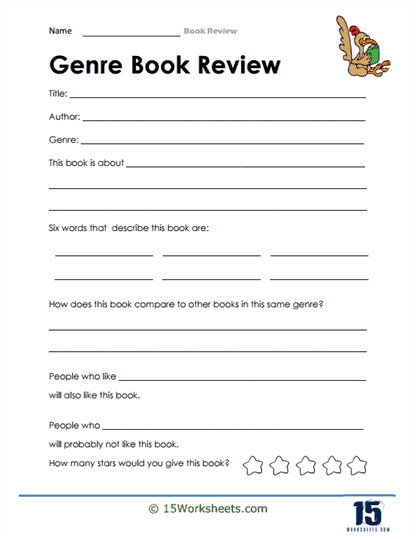
Genre Navigator
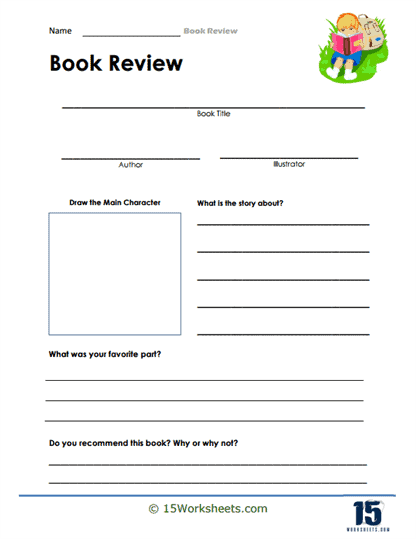
Main Character Feature
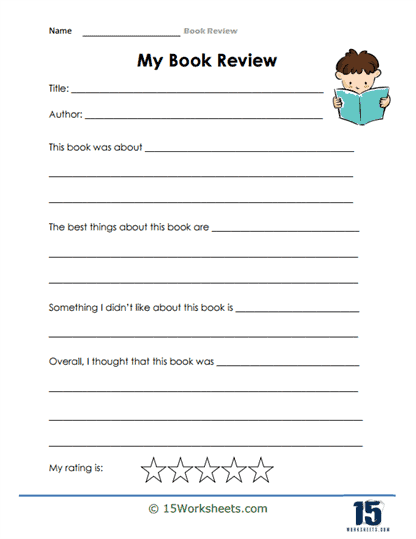
A Literary Critique
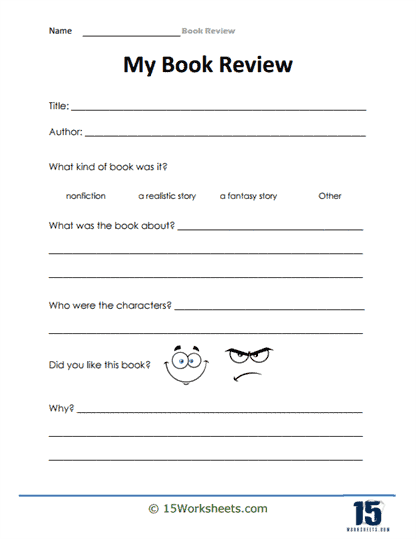
Express And Reflect
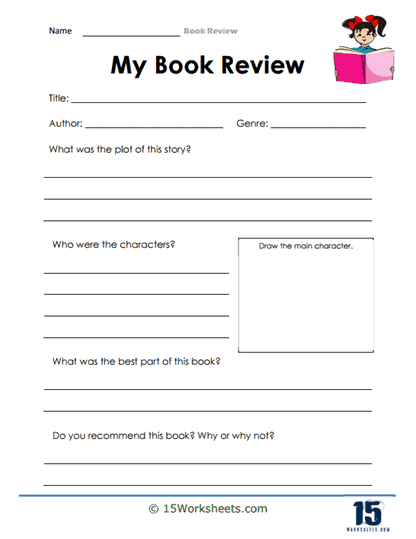
The Best Part
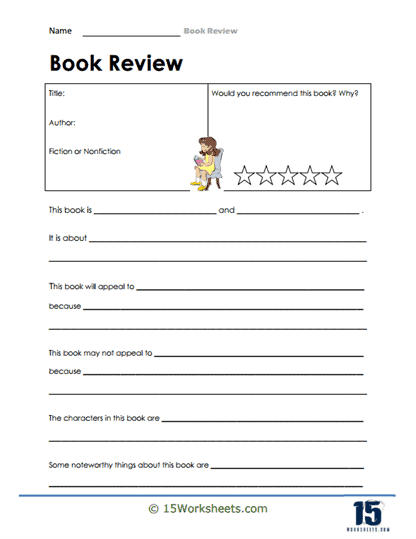
Describing The Appeal
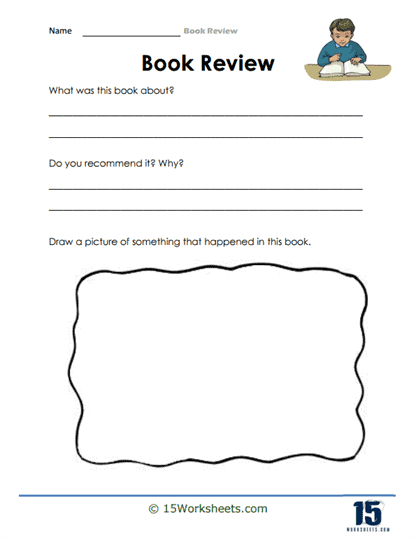
Sketching The Most Noteworthy
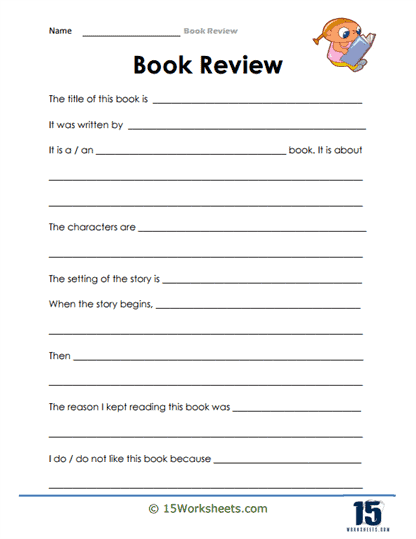
Complete The Thought
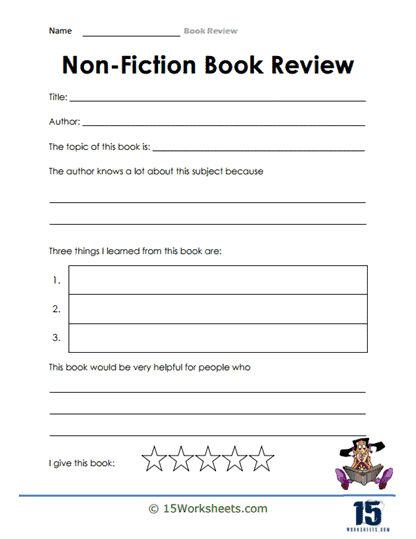
Exploring Nonfiction
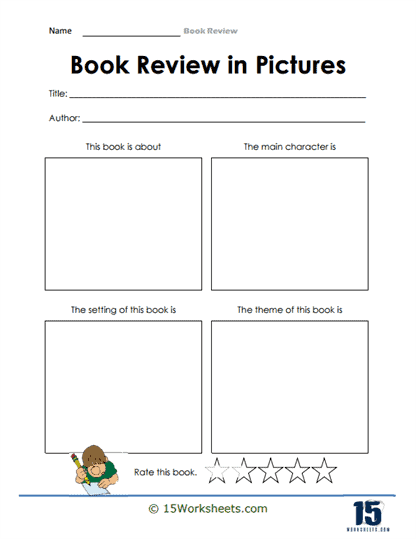
Creative Evaluation
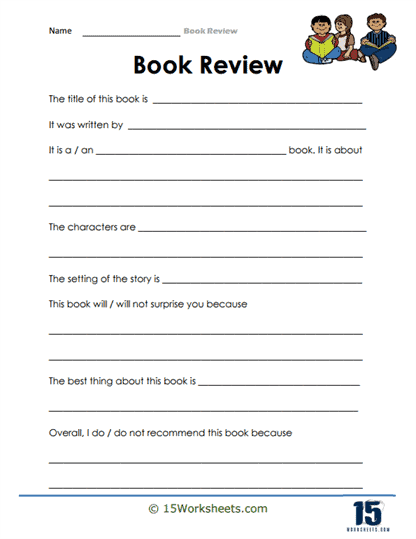
Voice Your Thoughts
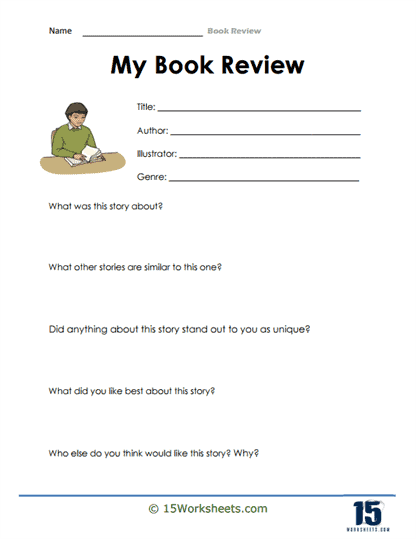
Book Appreciation Guide
All about these 15 worksheets.
This collection of Book Review worksheets are designed to encourage students to read, analyze, and evaluate books. These worksheets include prompts and questions that help students summarize the book’s plot, identify key themes and characters, and critically evaluate the author’s writing style and message.
The worksheets prompt students to reflect on their own opinions and experiences with the book, asking them to articulate what they liked or didn’t like, and why. This encourages students to develop their critical thinking and analytical skills, as well as their ability to communicate their thoughts and ideas effectively. Through these worksheets, students will:
- Learn how to construct a book review by being guided through writing prompts that ask them to express their own observations and opinions;
- Improve their critical thinking skills and become more discerning readers by rating the books they read and formulating their reasons for recommending or not recommending them;
- Develop their reading comprehension as creating book reviews require them to have a good understanding of the book’s plot, characters, and themes;
- And improve their writing skills as they organize their thoughts and ideas in a clear and concise manner to answer the writing prompts and various activities.
By engaging with books in this way, students can develop a love of reading, improve their writing and analytical skills, and deepen their understanding of the world around them. Moreover, successfully writing a book review can be a rewarding experience for students, as this boosts their confidence and encourages them to take on more challenging writing assignments in the future.
How to Review a Book?
A book review is a critical argument that lets others know your views and opinion regarding a book. Whether you are a literature student or a passionate book blogger, writing a book review is an important skill.
People love to read other people’s opinions regarding their favorite books or books they are planning to buy and read. So you must always give an honest review to let your fellow readers know whether a book will meet up to their expectations or not.
When writing a book review, you must always imagine the reader sitting in front of you, listening to what you have to say regarding the book. You can follow these five stages in writing a book review that is proven to grab your audience’s attention.
A hook is a catchy line or famous quote from the book that would capture the attention of your reader right away. You can also write a compelling one-line sentence that would make your audience keep reading your review instead of skipping it. Make sure you don’t spoil the book or write about the major plot twist.
Taking the example of the most beloved book by Jane Austen, Pride and Prejudice, you can write the first line as a hook, if it is famous and exciting, like “It is a truth universally acknowledged, that a single man in possession of a good fortune, must be in want of a wife.”
Or you can add any other quote that describes the story’s plot. E.g., “I could easily forgive his pride, if he had not mortified mine.”
2. Write About the Main Subject of the Book
The title and author information of the book is important, but in addition to that, you must talk about the genre and general themes of the book. Your audience must know what kind of book they are reading.
There is nothing more frustrating than picking up a book with a title like “To kill a mockingbird” and then reading it to find out it has nothing to do with birds and everything to do with racial injustice, rights and wrongs in a small town, and a defense lawyer raising two kids by himself.
Share a short synopsis or a summary of the plot of the book. It should let the readers know what they are getting into. Talk about the main characters, the major conflict, a little bit about the plot and setting, and make sure you leave out the plot twist and the book’s climax.
Add an exciting cliffhanger at the end of your summary, giving your readers just the right bait to read it but withholding the big mystery which would compel them to read the book.
Take a look at this blurb for the book Stardust by Neil Gaiman.
“To win the heart of his beautiful Victoria, Tristran Thorn would go to any lengths, even as far as entering the unexplored and dark lands on the other side of the ancient wall to retrieve a fallen star. Once he is beyond that cold stone wall, Tristran learns how nothing can be trusted, not even the beautiful and exhilarating Faerie.”
4. Praise and Critique
Your personal opinion, likes, and dislikes set your book review apart from the others. If your reading choices and preferences resonate with your audience, they will be interested in listening to what you have to say regarding the book. Sharing your review as a reader would let others decide whether they would enjoy reading the book or not, for example. “Daphne Du Maurier so passionately described the confidence and strong presence of Rebecca that even I, as a reader, felt intimidated by her, all the while admiring her too.”
5. Your Recommendation and Ratings
Summarize your review by recommending the book to your readers. You can rate the book if you want and let others know that if they are interested in a particular genre of books, they will enjoy this book as well. Let your readers know that all the opinions stated are your own, and the rating you have given the book is based upon your perception of the book.
Before posting your book review, proofread it to eliminate any grammatical errors. Keep your reviews short and streamlined to ensure every word has weight. Get your point across without causing any confusion, and most importantly, do not write mean or dishonest reviews criticizing a good book when it is not required at all.
How Are Books Reviewed?
Books can be reviewed in various ways, depending on the reviewer’s purpose, audience, and platform. Here are some common types of book reviews.
- Professional reviews: These reviews are written by professional book critics and journalists for newspapers, magazines, and online publications. They typically follow a specific format, including a summary of the book’s content, analysis of the author’s writing style, and an evaluation of the book’s strengths and weaknesses.
- Academic reviews: Scholars and subject matter experts write these reviews for academic journals, focusing on the book’s contributions to a particular field of study. They provide a detailed analysis of the book’s argument, methodology, and use of evidence, and often compare it to other works in the field.
- Blog and website reviews: Many bloggers and website owners write book reviews as part of their online content. These reviews can vary in length and style, from informal and personal reflections to more structured evaluations.
- Peer reviews: In some cases, authors may seek feedback from their peers before publication. These reviews can help identify strengths and weaknesses in a manuscript and suggest improvements to make the work more rigorous and engaging.
- Reader reviews: Readers often share their thoughts on books through various platforms like Goodreads, Amazon, and other online retailers. These reviews can be brief or lengthy and may focus on personal impressions, emotional responses, or recommendations for other readers.
- Social media reviews: Many people share their thoughts on books through social media platforms like Facebook, Twitter, and Instagram. These reviews are usually short, informal, and may include images or hashtags to emphasize key points.
- Book club discussions: Book clubs provide a forum for readers to discuss and review books in a group setting. Participants share their opinions, ask questions, and engage in lively conversations about the book’s themes, characters, and plot.
- Video reviews: Booktubers and other content creators on platforms like YouTube and TikTok create video reviews that can include visual elements, author interviews, and even dramatic reenactments of key scenes.
- Podcast reviews: Some podcasts are dedicated to discussing and reviewing books, offering listeners an in-depth exploration of a book’s themes, characters, and writing style, often in a conversational format.
- Interviews and author discussions: Sometimes, reviews can take the form of interviews with the author or panel discussions at book events, where the book’s content, themes, and intentions are discussed in detail.

- Kindergarten
- Holidays/Seasonal
- Cursive Letters
- Coloring Pages

Book Review Template for Kids
Are you looking for a book review template for older kids? This simple book review template is ideal for grown-up children. Prompt your child to write a book review each time after finishing a book. It will encourage them to brainstorm and share their viewpoint.
Reading books and writing reviews also aids in developing good literacy skills. Other than writing reviews, you can also ask your child questions about the book. Not only they will learn how to analyze and evaluate, but it will also start a healthy conversation with them.
Book Review Format
Book reviews are not just a summary of the plot; they are your ticket to sharing your thoughts, opinions, and insights about a literary work with the world. Crafting an engaging book review requires more than just enthusiasm – it demands a well-structured format that brings out the essence of the book and your perspective on it. Here’s a simple format guide to help you master the art of writing a captivating book review if you are writing one for young kids or want your kids to master it.
- Introduction: Introduce the author, the book’s title, and provide some context about the book’s significance. Then, kick off with a catchy sentence that makes us want to read more. How about a sneak peek into the most exciting part?
- Peek into the Plot: Give us a taste of the story without giving away all the secrets. Who are the main characters? What’s the adventure they’re going on? But remember, no spoilers are allowed! Keep it engaging and intriguing to pique the reader’s curiosity.
- Characters’ Corner: Let’s talk about the characters. Did you find a friend in one of them? Who made you laugh the most? Share your thoughts and tell us what you liked about them. Dive into the characters’ personalities, motivations, and development throughout the story.
- Story Themes and Lessons: What did the book teach you? Did it make you see things differently? Maybe it had a big message hidden in the story. Tell us what cool things you learned.
- Style Spotlight: Describe how the author writes. Is it funny and clever? Does it feel like magic? Let us know if the words painted pictures in your mind as you read.
- Twists and Turns: Discuss any plot twists, surprises, or turning points that added excitement or depth to the story. Did the story have any surprises that made you gasp? Maybe a twist that you never saw coming? Spill the beans on those exciting moments!
- Your Feelings Matter: Did the book make you smile, cry, or laugh out loud? Share how the story made you feel and why those emotions were bubbling up.
- The Big Finish: Wrap up your review by sharing your final thoughts. Did you absolutely love the book? Would you tell your friends to read it? Tell us if this adventure is a must-read or not, and why you think so.
Remember, a book review is your chance to share your thoughts and feelings. There’s no right or wrong – it’s all about your unique perspective. Your review could help another young reader find their next favourite book. So, have fun writing, and let your excitement shine through!
Related: Fun Kids Resources

Book Review & Report Templates
This book review template for kids includes the following questions:
What was the title of the book? Who was the author of the book? What did you like best/least about this book? Would you recommend this book to your friends? Why or why not? Which characters in this book did you like the best? Describe their traits What happened in the story? What was your favourite part?
Print the pdf file by clicking the pictures below or the download button.
Simple One-Page Book Review Template
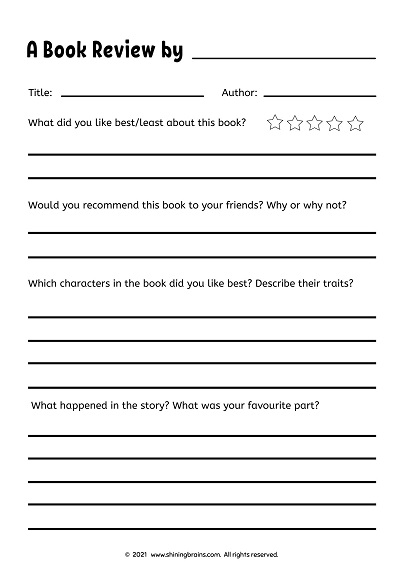
Book Report Template for KS1, KS2 and KS3 Kids
Click the below book report template for ks1 ks2 and ks3 kids to download.
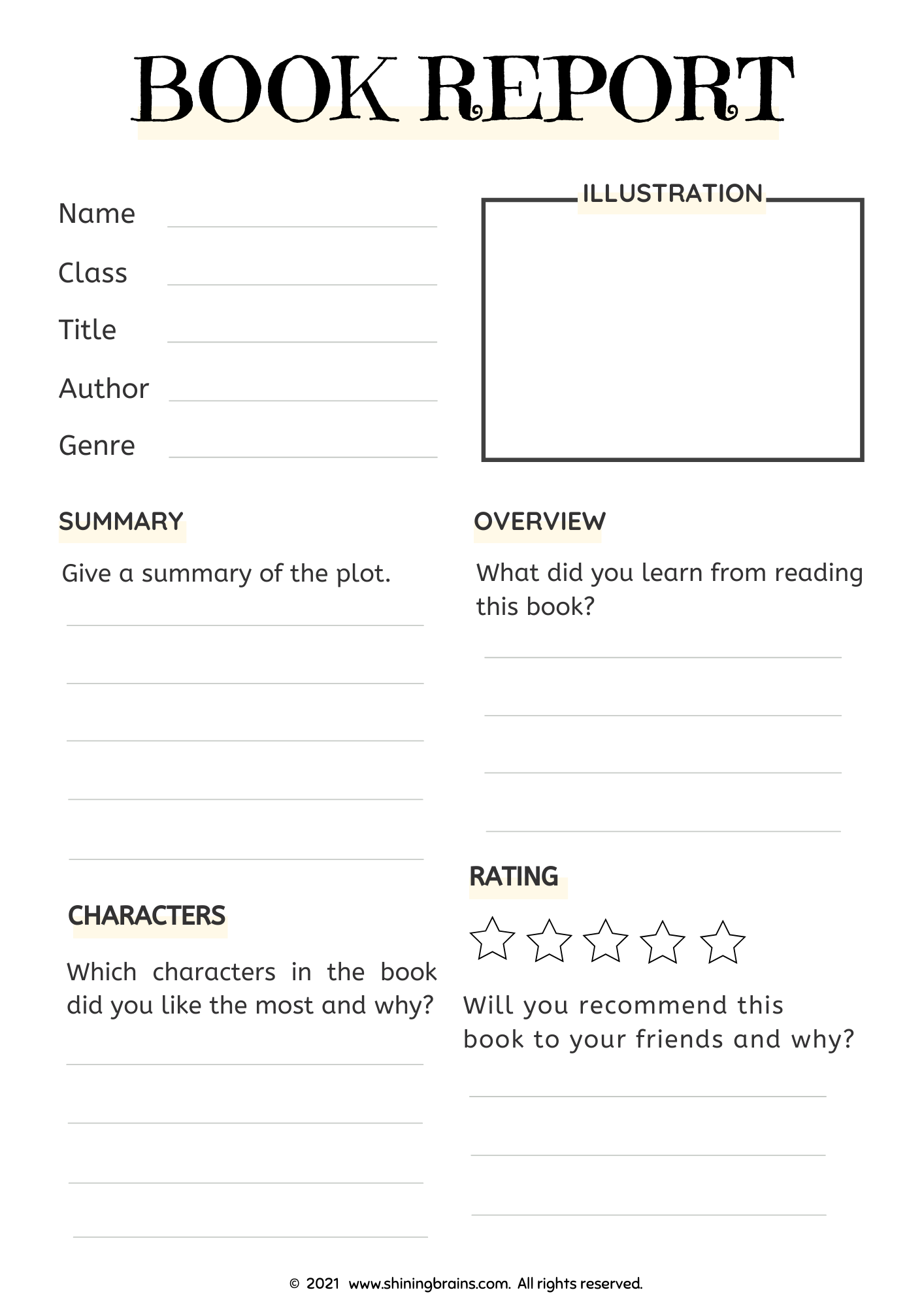
Fun Simple Book Review Template
Click the below book review template for ks2 kids to download.
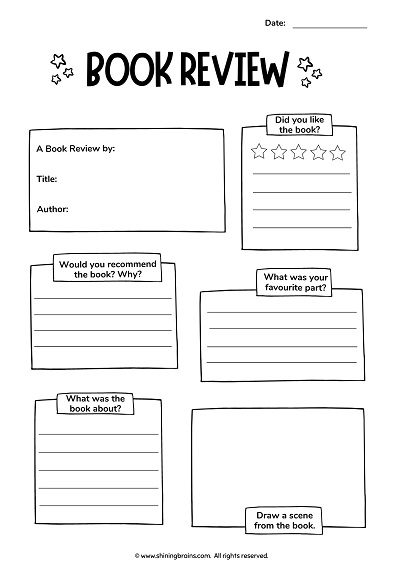
Book Report Template Worksheet
Click the below book report template for ks1, ks2 kids to download
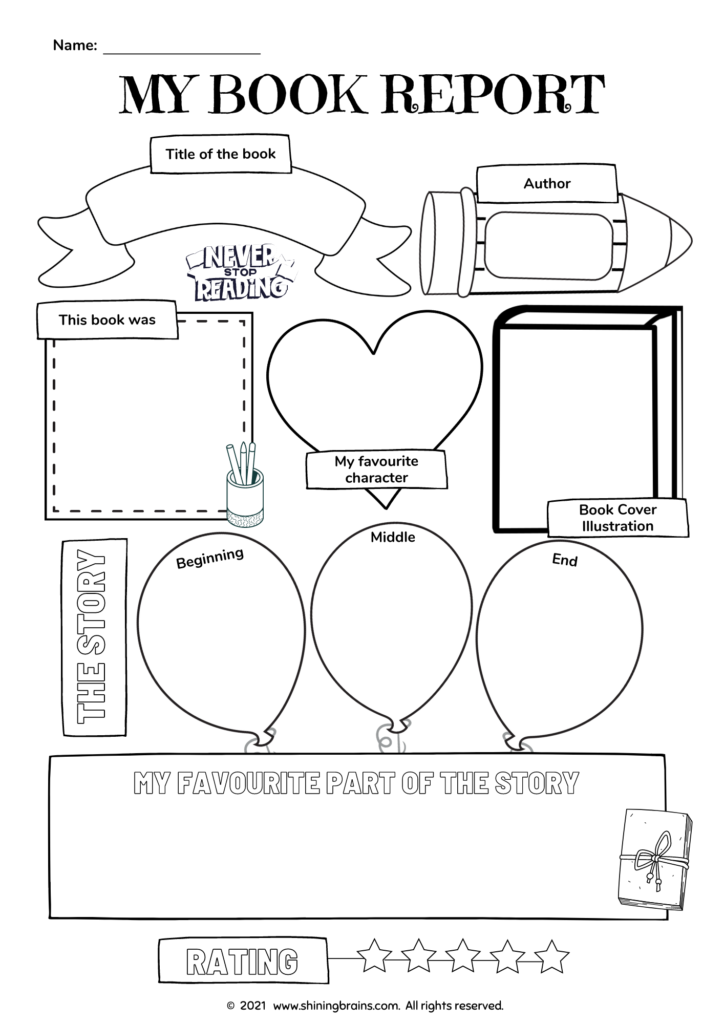
In-depth Book Review Template
Click the below extensive book report template bundle to download.
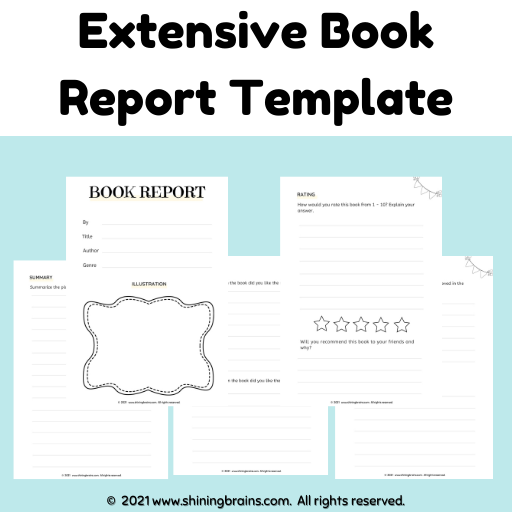
Also, Check: Quiz Questions for Kids
What is the purpose of a book review?
A book review serves the purpose of providing potential readers with insights and information about a book. It offers an evaluation of the book’s content, style, and overall quality. Additionally, book reviews help readers decide whether the book aligns with their interests and whether it’s worth investing their time in reading it.
What is the format of a book review?
A typical book review follows a structured format that includes an introduction, a brief summary of the book’s content and context, an analysis of its strengths and weaknesses, a discussion of characters and themes, and a concluding evaluation. The introduction engages the reader, the summary offers a snapshot of the book, the analysis delves into its various aspects, and the conclusion provides a final recommendation or judgment. This format ensures a comprehensive and organized review that informs readers while conveying the reviewer’s perspective effectively.
Why is it important to include a brief summary of the book in a book review?
Including a brief summary of the book in a review helps readers understand the context and premise of the book. This summary provides essential background information, introduces key characters and plot elements, and ensures that readers have a basic understanding of what the book is about before delving into the reviewer’s analysis and opinions.
In a book review format, what does the “Introduction” section typically include?
The “Introduction” section of a book review typically provides a hook to capture the reader’s interest. It may contain background information about the author, the book’s genre, and its relevance. The introduction also sets the tone for the review and often includes a thesis statement that gives a hint of the reviewer’s overall opinion.
What key information should be covered when discussing characters in a book review?
When discussing characters in a book review, key information to cover includes their names, roles, and significance within the story. It’s important to analyze their development, motivations, and how they contribute to the plot’s progression. Mentioning whether the characters are relatable or well-crafted adds depth to the review.
Why is sharing your personal feelings and opinions important in a book review?
Sharing personal feelings and opinions in a book review adds a subjective element to the analysis. Readers often connect with reviewers who express genuine emotions, and this can help potential readers determine if their tastes align with the reviewers. However, it’s crucial to balance personal opinions with objective analysis to provide a well-rounded evaluation of the book’s merits and drawbacks.
Can I share this resource?
You can surely share the link to this resource post so other people can also download it from here. This is for personal or personal classroom use only. To share, please share a link to this page, not the file. You cannot include these worksheets in your product or upload them to your site and have people download them from there because that would be copyright violations .
This may not be hosted or stored on any other site (including Facebook, Dropbox, etc.)
Share this resource and write a review below. Please like and follow our Facebook & Instagram pages to stay updated. Thank You!
3 thoughts on “Book Review Template for Kids”
Excellent blog post. I certainly appreciate this site. Stick with it!
Hi Mahlikka, I am glad you found this post useful 🙂 Thanks for your appreciation.
Your insights are a valuable contribution to the discussion.NaN
Leave a Comment Cancel reply
Save my name, email, and website in this browser for the next time I comment.
Related Posts
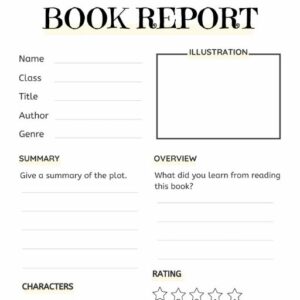
Book Report Template for Ks1, Ks2 and Ks3 Kids | Book Review
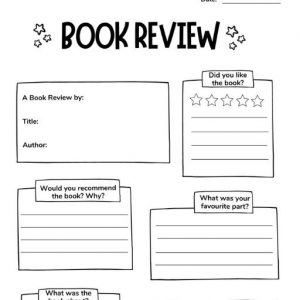
Book Review Frame for kids – Great Reading & Writing Activity
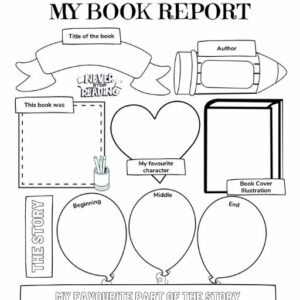
Book Report Template | My Book Report Writing
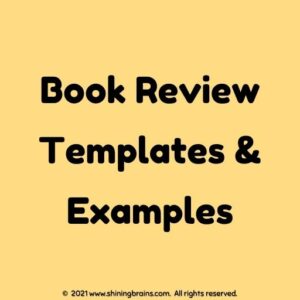
All About Book Reviews – How to write a book report
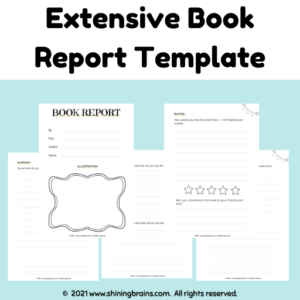
Extensive Book review writing template bundle
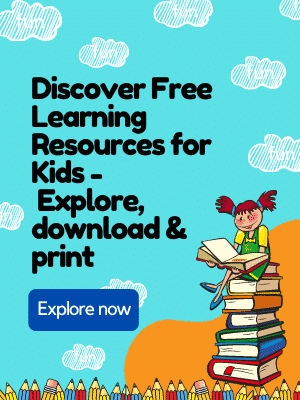
Popular Posts
- Daily Schedule for Kids - Free Cute Editable Timetable Template
- Timetable for kids | Weekly Timetable Template | Free Printable
- Alphabet Worksheets for Kids | Alphabet Free Activities for Kindergarten
- 150+ Best Quiz Questions for Kids with Answers - Fun Trivia
About Shining Brains
Takedown Policy
©2023 shiningbrains.com All Rights Reserved.
MSL Book Review
Book review worksheets.
The following templates can be used to create excellent book reviews. Feel free to download these worksheets to use during and/or after your reading of a book.
Book Review Worksheet – Fiction Chapter Book
Book Review Worksheet – Nonfiction Book
Book Review Worksheet – Picture Book

IMAGES
VIDEO